HIPAA Compliance Checklist for 2025

Are your IT teams still spending hours configuring devices, fixing network issues, and managing repetitive tasks manually? In today’s digital world, manual network management can’t keep up.
That’s why IT leaders use network automation tools to save time, reduce errors, and improve efficiency by automating setup, configuration, and compliance tasks.
By 2026, 30% of enterprises will automate more than half of their network activities, proving that automation isn’t optional anymore; it’s essential.
With so many network automation tools available in the market, how do you know which one fits your enterprise best?
To make the choice easier, let’s explore the top 10 network automation tools for modern IT teams in 2025, including enterprise-grade solutions and the best open-source alternatives for multi-vendor network automation.
TL;DR
- Manual network management is becoming a thing of the past. Network automation tools help IT teams save time, reduce errors, and maintain reliable performance across complex environments.
- The right network automation solution automates device setup, configuration updates, and policy enforcement, helping teams work smarter and faster.
- Network config automation keeps networks secure and compliant by applying updates automatically and preventing configuration drift.
- AI-powered network automation tools can predict outages, optimize traffic, and even self-heal networks before users notice an issue.
- With automation, compliance and security become easier, tools automatically enforce standards like ISO 27001, SOC 2, and NIST across all devices.
What Are Network Automation Tools?
Network automation tools are software solutions that help IT teams manage, configure, and monitor networks automatically, without the need for constant manual effort.
They handle repetitive tasks like setting up devices, updating configurations, checking compliance, and troubleshooting issues. By automating these processes, teams can save time, reduce human error, and keep networks running smoothly.
This network automation lets IT teams focus on strategy and innovation instead of routine maintenance. Whether it’s through scripts, APIs, or AI-driven workflows, these tools help build faster, more secure, and more reliable networks.
Key aspects of network automation tools:
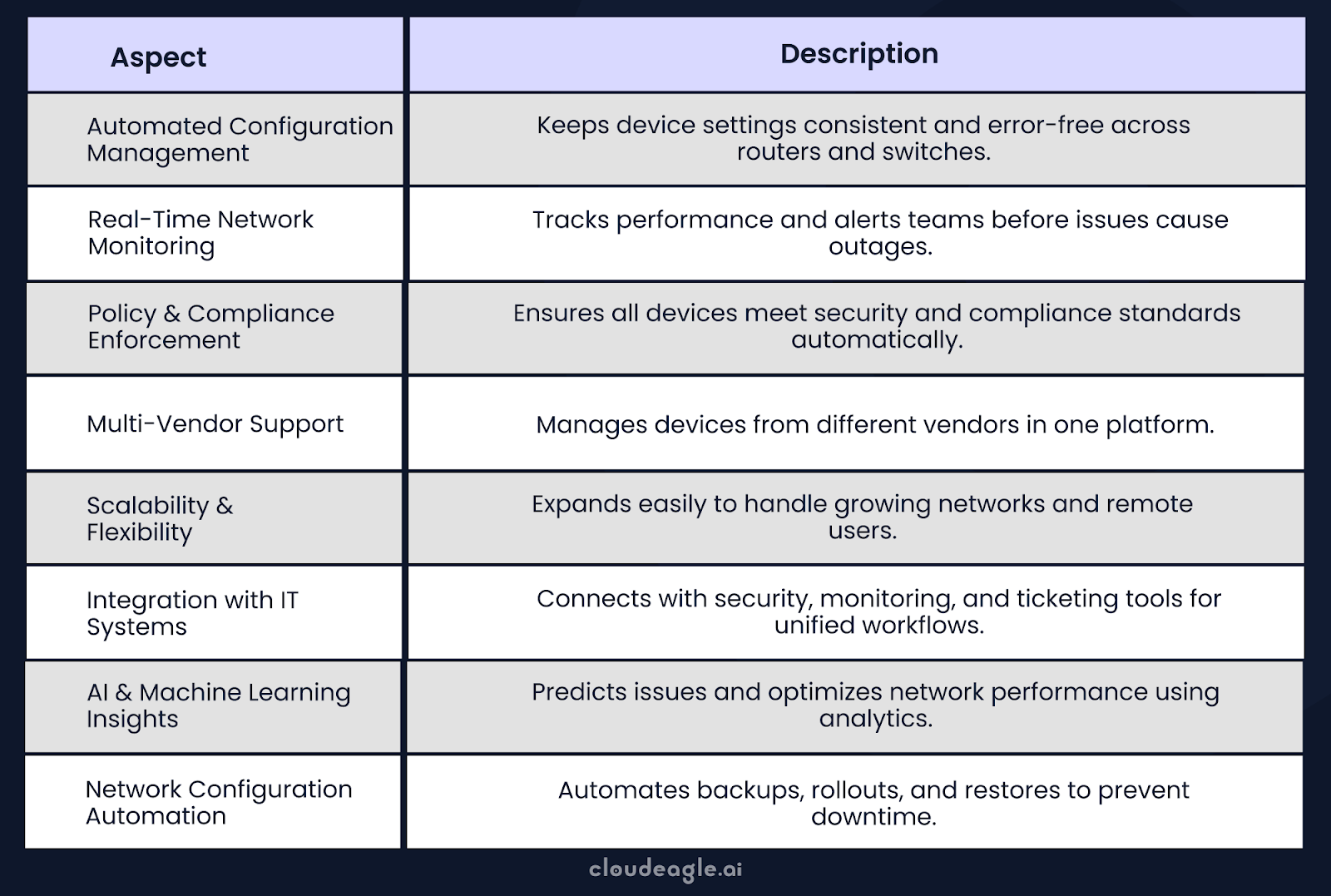
Benefits of Using Network Automation Tools
IT leaders are investing in network automation tools to simplify operations, increase visibility, and boost performance across hybrid and multi-vendor environments.
Here are the key benefits of using a network automation solution:
1. Reduced Manual Errors and Configuration Drift
Human error is one of the leading causes of network downtime. Network automation tools eliminate these risks by automating repetitive tasks like configuration updates, device provisioning, and compliance checks. They also prevent configuration drift, when settings change over time and no longer match policy standards.
2. Improved Network Visibility and Uptime
You can’t protect what you can’t see. Network automation tools provide real-time insights into device status, bandwidth usage, and performance metrics across your infrastructure. With automated monitoring and intelligent alerts, IT teams can detect issues early, resolve them quickly, and avoid downtime.
Know how Heath Ceramic's IT and Finance team got 100% SaaS visibility using CloudEagle.ai.
3. Cost Efficiency and Faster Deployments
Automation saves time and money by replacing manual work with faster, smarter processes. Instead of updating devices one by one, network automation tools can apply changes to thousands at once, cutting costs, reducing mistakes, and giving IT teams more time to focus on important projects.
4. Enhanced Compliance and Security
Compliance frameworks like ISO 27001, NIST, and PCI DSS demand accurate, up-to-date configurations. Network config automation ensures that every device follows defined security policies and instantly flags any deviations. Automated audits, logs, and policy enforcement help maintain compliance without manual effort.
5. Better Scalability and Flexibility
As companies scale, their networks become larger and harder to manage manually. Network automation tools make scaling simple by automating device setup, policy updates, and configuration changes across all systems. Whether you’re managing hundreds or thousands of devices, automation keeps your network consistent, reliable, and secure.
6. Faster Incident Response and Troubleshooting
When network problems happen, automation helps teams fix them faster. Smart tools can find, isolate, and even solve issues automatically before anyone notices. With AI and analytics, network automation tools spot warning signs early and suggest fixes, turning quick reactions into smart prevention.
7. Improved Collaboration Between IT and Security Teams
Automation also brings network, security, and operations teams together. By using a unified platform, teams can share data, streamline workflows, and respond quickly to risks or compliance alerts, reducing silos and improving coordination.
What Are the Different Types of Network Automation Tools?
Not all network automation tools work the same way. Some focus on simple configuration tasks, while others manage entire network lifecycles, from provisioning to performance optimization.
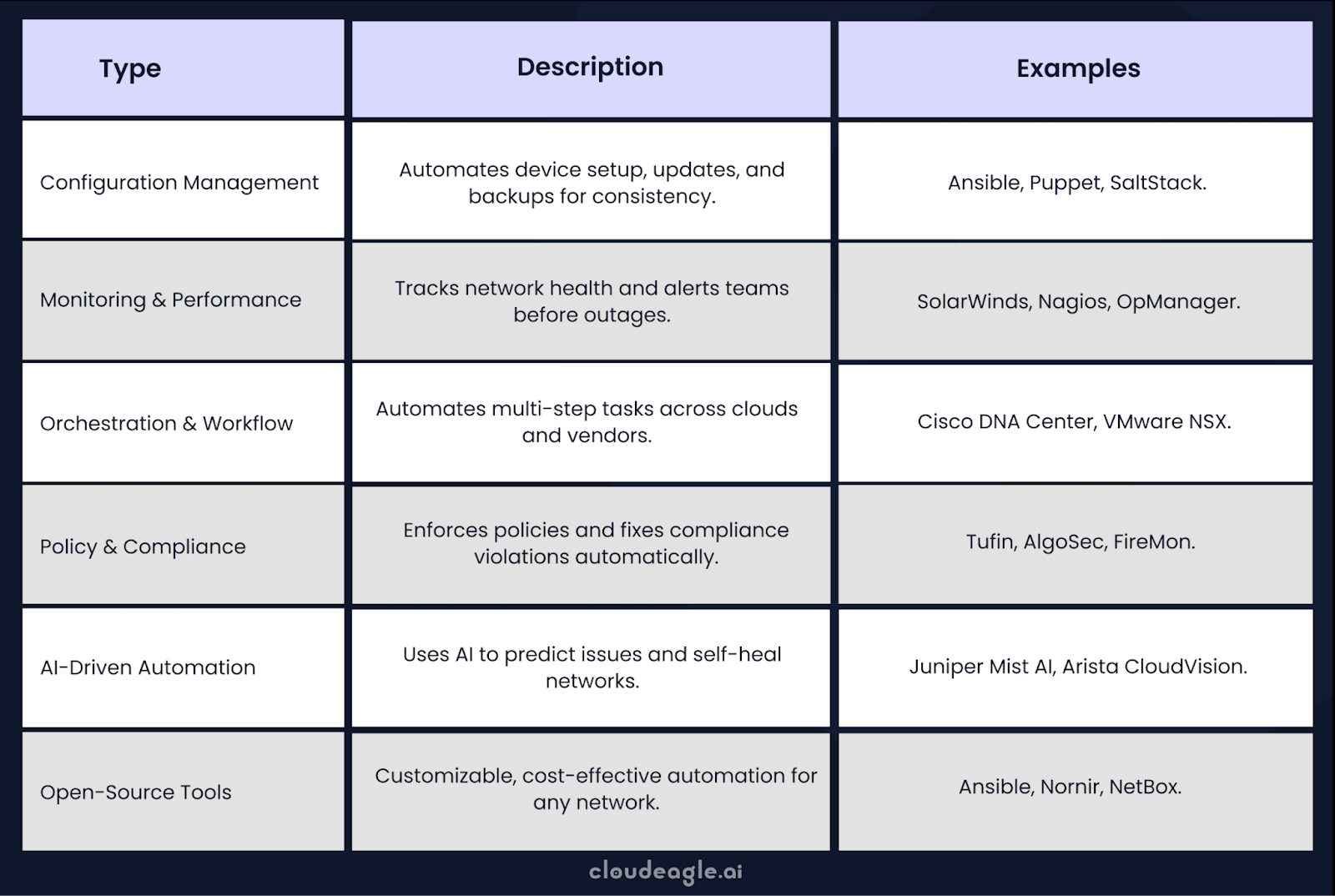
Here are the main types of network automation tools used by modern IT teams:
1. Configuration Management Tools
These tools automate device setup, updates, and backups. Instead of changing configurations one by one, IT teams can push updates to hundreds of devices at once. They help keep settings consistent, reduce errors, and make managing large networks easier.
2. Network Monitoring and Performance Tools
These tools keep an eye on network health by tracking traffic, speed, and device performance. They alert IT teams before small issues become big outages and can even trigger automatic fixes to keep everything running smoothly.
3. Orchestration and Workflow Automation Tools
These tools handle complex network tasks across multiple systems or vendors. They automate things like provisioning, scaling, and configuration changes across data centers and clouds—ideal for managing large or hybrid networks.
4. Policy and Compliance Automation Tools
These tools check if all network devices follow company and industry security rules. They automatically fix issues, create audit reports, and help teams stay compliant with standards like ISO 27001 or NIST.
5. AI-Driven Network Automation Tools
These use AI and machine learning to predict problems before they happen. They can adjust settings automatically, fix issues on their own, and optimize network performance for better uptime.
6. Open-Source Network Automation Tools
These tools are flexible and budget-friendly. They allow IT teams to customize and build their own automation workflows using scripts or APIs, perfect for teams that need full control and multi-vendor support.
Top 10 Network Automation Tools for 2025
As networks grow more complex, manual management just can’t keep up. These top network automation tools of 2025 help IT teams save time, reduce errors, and keep networks secure and efficient.
1. CloudEagle.ai
CloudEagle.ai is an advanced SaaS management and access governance solution with advanced network automation capabilities built for IT, security, and procurement teams.
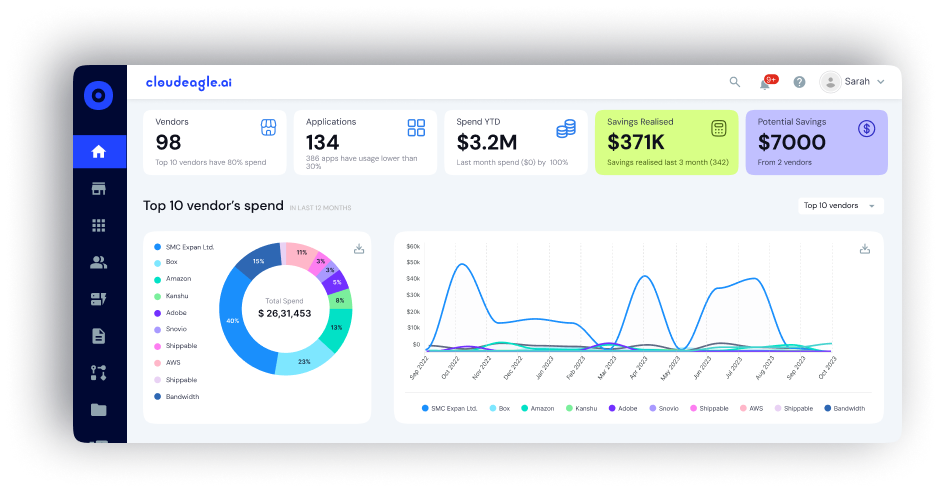
It gives enterprises complete visibility into their SaaS stack, automates access control, and reduces security and compliance risks. With AI-driven automation and 500+ integrations, CloudEagle.ai keeps your SaaS network secure, efficient, and compliant.
Key Features
1. Centralized Access Visibility & Control
CloudEagle.ai acts as your single source of truth for SaaS access across the enterprise. It gives IT and security teams complete visibility into who is using which apps, what access levels they have, and how often those apps are used.
The platform:
- Identifies unused or risky applications instantly.
- Detects overlapping licenses and consolidates tools to save costs.
- Monitors access behavior across departments in real time.
This centralized view helps eliminate blind spots, reduce redundancy, and strengthen your enterprise’s overall SaaS security posture.
2. Automated Access Governance
According to CloudEagle.ai’s IGA Report, 95% of organizations still conduct access reviews manually; a process that isn’t feasible when managing thousands of access requests monthly.
These manual access reviews are time-consuming and prone to errors. CloudEagle.ai automates the entire process; from onboarding new users to revoking access when employees leave.

By automating app access reviews, CloudEagle.ai helps ensure that only the right users have access to the right apps, at the right time, without slowing down operations.
Know how Dezerv automated its app access review process with CloudEagle.ai.
3. SaaS Risk and Shadow IT Detection
Unauthorized SaaS usage, or Shadow IT, can expose sensitive data and create serious compliance risks. CloudEagle.ai automatically detects and mitigates these threats before they escalate.

The platform:
- Scans SSO logs, expense systems, network data, and browser activity to uncover all SaaS usage.
- Instantly flags risky, duplicate, or non-compliant applications for review.
- Provides risk scoring to help IT teams prioritize high-impact threats.
This proactive detection eliminates hidden vulnerabilities, strengthens visibility, and ensures every SaaS app in your ecosystem meets enterprise governance and compliance standards.
4. Auto-Provisioning and Deprovisioning Workflows
Manual onboarding and offboarding can be slow and risky—especially in large enterprises managing hundreds of SaaS apps. CloudEagle.ai automates this process through intelligent provisioning and deprovisioning workflows.
When a new employee joins, the platform automatically grants access to approved apps based on their department, role, or location.

Likewise, when someone leaves or changes roles, CloudEagle.ai instantly revokes all permissions across connected systems.

This automation eliminates human error, speeds up access management, and ensures no lingering accounts remain—reducing security gaps and ensuring compliance with identity and access governance policies.
Know this story of how Treasure Data streamlined employee offboarding using CloudEagle.ai.
5. Role-Based Access Control (RBAC)
With role-based access control (RBAC), admins can define user roles, such as Finance, HR, or Engineering, and assign permissions accordingly.
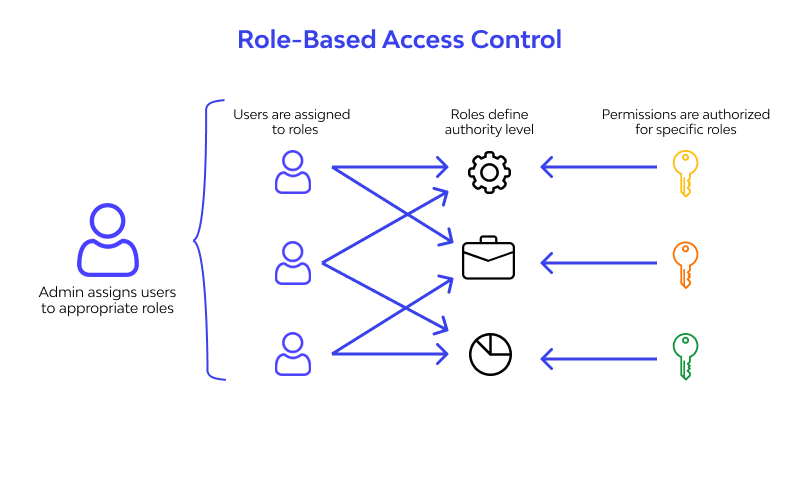
This feature helps:
- Streamline access management across teams and departments.
- Minimize over-permissioning and follow the principle of least privilege.
- Simplify compliance with frameworks like ISO 27001 and SOC 2.
This structured approach keeps user access consistent and traceable while reducing human error in permission assignments.
6. Just-In-Time Access Governance
Temporary or project-based access can be risky if not revoked on time. CloudEagle.ai introduces just-in-time access, ensuring employees, contractors, or vendors only retain permissions as long as needed.
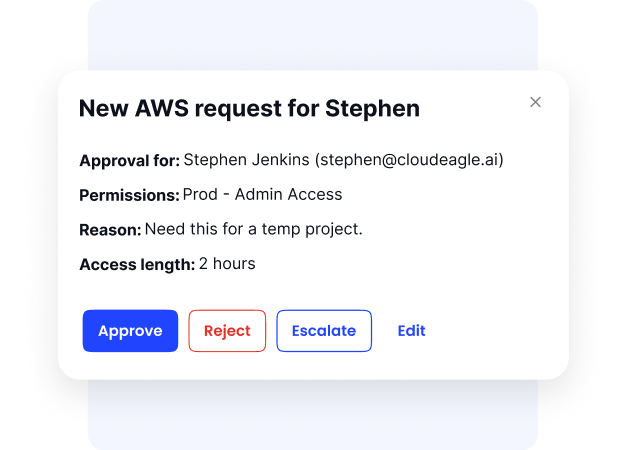
- Grant temporary access automatically with expiration timers.
- Auto-remove access after project completion or contract end.
- Reduce lingering accounts that can lead to breaches.
This feature keeps your environment secure by ensuring all access is relevant and current.
7. Privileged Access Management (PAM)
Privileged accounts have elevated permissions that, if compromised, can lead to major data breaches. CloudEagle.ai strengthens PAM through automation and visibility.
The platform,
- Tracks and manages privileged user sessions in real time.
- Automates approval workflows for elevated access requests.
- Instantly revoke privileges when no longer needed.
With CloudEagle.ai, you can control and audit every privileged action, minimizing insider threats and unauthorized changes.
8. Compliance Automation and Audit Readiness
Staying compliant with standards like ISO 27001, SOC 2, GDPR, or HIPAA can be challenging without automation. CloudEagle.ai simplifies compliance by:
- Automatically mapping policies and risks to compliance frameworks.
- Maintaining detailed logs and reports for every action.
- Generating audit-ready evidence instantly when needed.
These automated checks ensure your enterprise remains continuously compliant and audit-ready year-round.
9. User-Friendly Access Request and Governance
CloudEagle.ai makes access governance easy for end users too. The self-service app catalog allows employees to request access to approved apps securely, with built-in workflows for IT and manager approval.
- Reduce IT ticket volume by automating access requests.
- Maintain full control with predefined approval workflows.
- Prevent the rise of shadow IT by guiding users to approved apps.
This balance of control and convenience improves productivity while keeping your SaaS environment secure and compliant.
Know how A gen ai company streamlined saas access provisioning with CloudEagle.ai’s self‑service app catalog.
10. Integration with Security Monitoring Tools
CloudEagle.ai integrates seamlessly with over 500 SaaS apps including identity, security, and IT management systems to deliver a connected automation ecosystem.
- Connects with Okta, Azure AD, ServiceNow, Slack, Jira, and others.
- Syncs user access data across systems for better visibility.
- Enables unified incident detection and response workflows.
These integrations make it easy to align IT, security, and compliance teams around a single source of truth.
Pros
- Eliminates shadow IT and strengthens SaaS security.
- Reduces access and network-related risks.
- Saves up to 30% on SaaS and software costs.
- Automates provisioning, deprovisioning, and access reviews.
- Improves compliance and audit readiness.
- Enhances IT efficiency with AI-driven automation.
- Provides real-time visibility across all SaaS apps.
- Simplifies employee access through a self-service app catalog.
- Integrates with 500+ tools like Okta, Azure AD, and ServiceNow.
- Scales easily for enterprise-level SaaS environments.
2. Cisco DNA Center
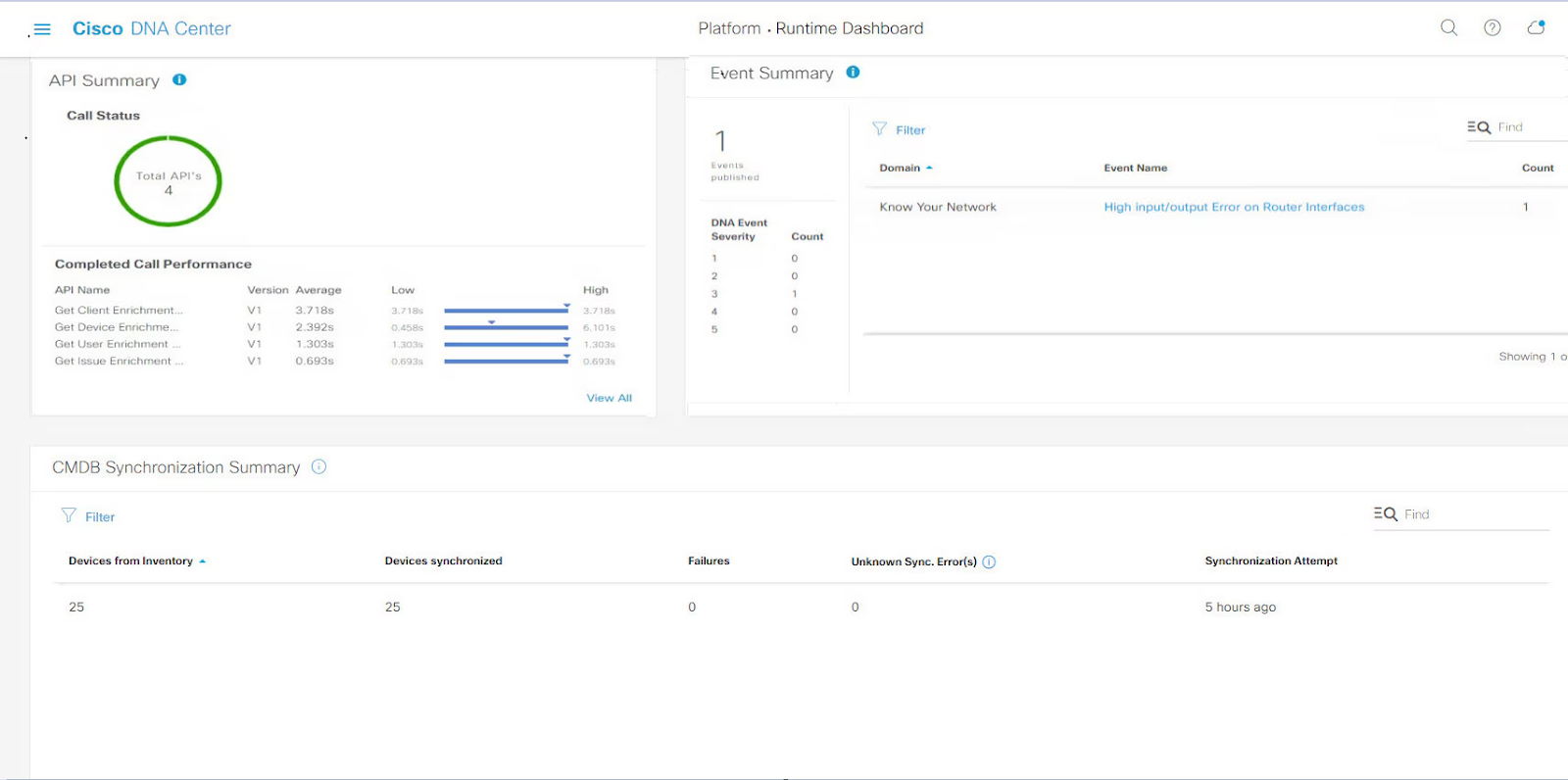
Cisco DNA Center is an AI-powered network automation tool that helps IT teams manage, monitor, and secure enterprise networks from one place. It automates tasks like provisioning, configuration, and policy enforcement while giving deep visibility into network performance. Built for enterprises using Cisco infrastructure, it helps teams move from manual management to intelligent, intent-based networking.
Key Features
- Centralized Automation: Automates configuration, provisioning, and software updates for Cisco devices from one dashboard.
- AI-Powered Insights: Uses analytics to detect issues, predict failures, and optimize network performance.
Pros:
- Seamless integration with Cisco systems.
- Strong automation and policy control.
Cons:
- Best suited for Cisco-heavy environments.
- Complex for small IT teams.
3. SolarWinds Network Configuration Manager (NCM)
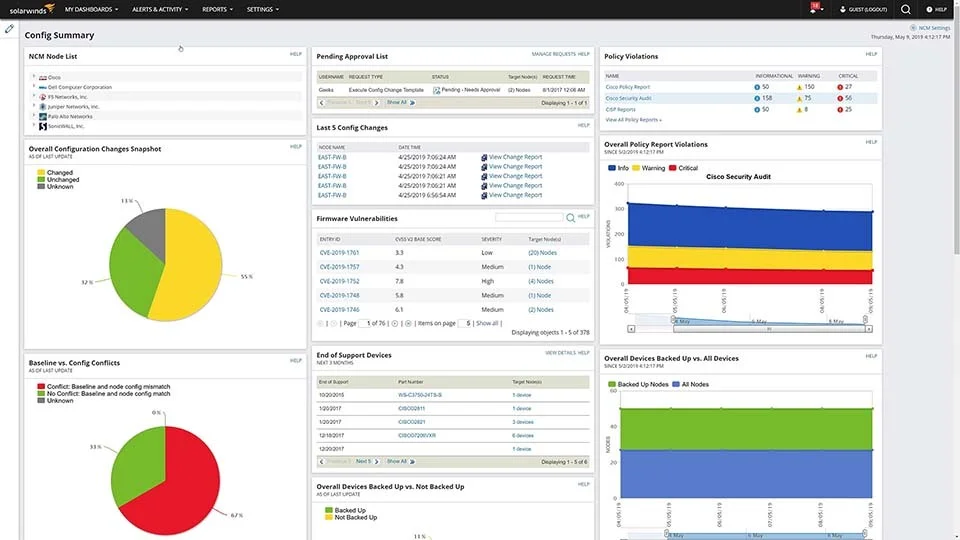
SolarWinds NCM is a reliable network configuration automation tool that simplifies managing multi-vendor networks. It automates configuration backups, compliance checks, and change tracking to keep networks consistent and secure. With real-time alerts and reporting, NCM helps IT teams detect issues early and maintain compliance across devices.
Key Features
- Automated Configuration Management: Backs up, updates, and restores configurations automatically.
- Compliance Monitoring: Scans and enforces network policies to meet security and audit standards.
Pros
- Excellent configuration visibility.
- Broad device compatibility.
Cons:
- Complex for large deployments.
- Occasional performance slowdowns.
4. Juniper Apstra

Juniper Apstra is an intent-based network automation solution that simplifies complex data center operations. It enables IT teams to define their desired network outcomes and automatically applies configurations to achieve them. With real-time validation and multi-vendor support, Apstra ensures reliability, consistency, and agility in modern enterprise networks.
Key Features:
- Intent-Based Networking: Defines outcomes and automates the path to achieve them.
- Continuous Validation: Constantly checks that the network matches intended policies.
Pros
- Strong cross-vendor automation.
- Real-time visibility and validation.
- Reduces configuration drift and risk
Cons:
- Steep learning curve.
- Primarily data center-focused.
5. Ansible
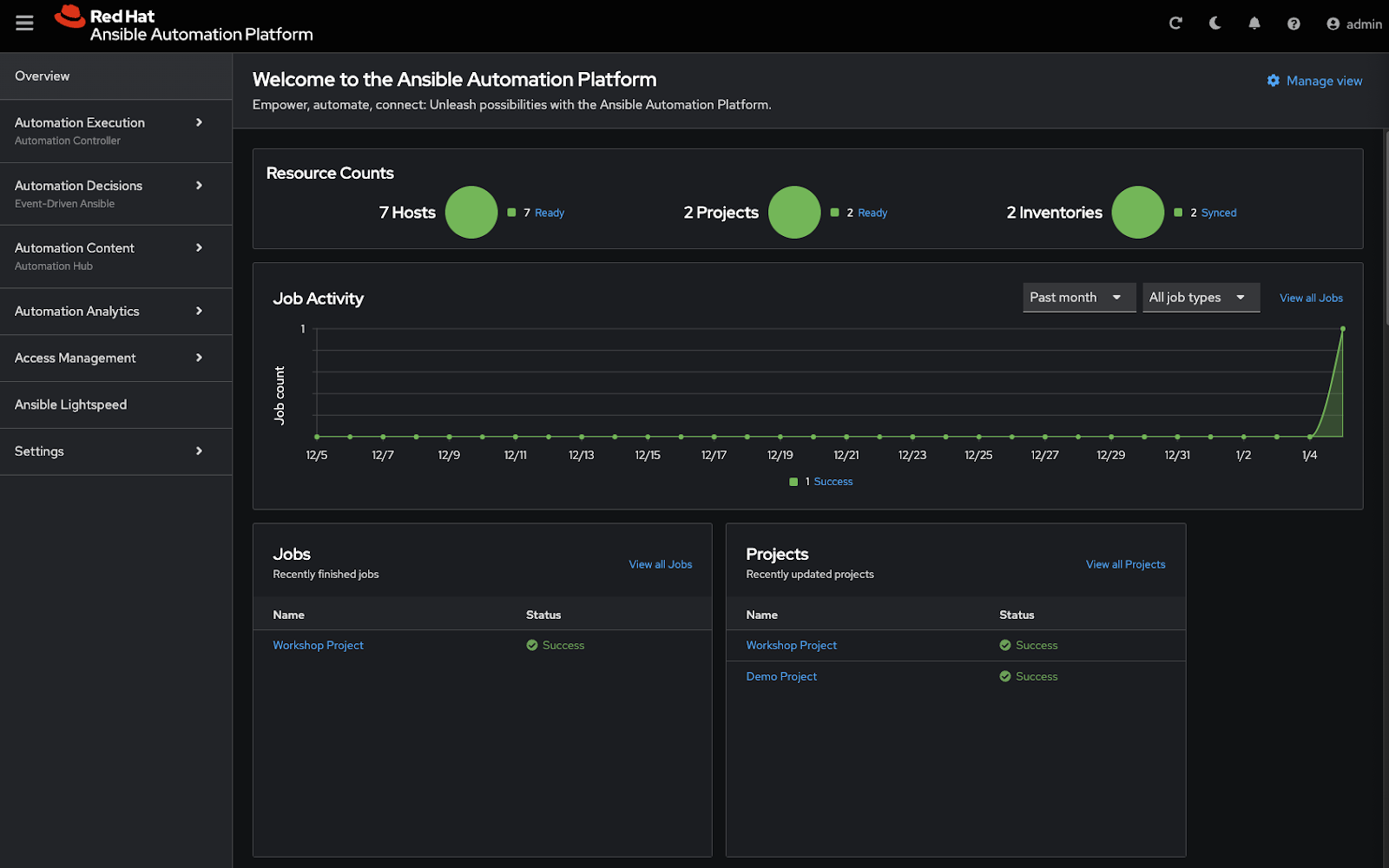
Ansible by Red Hat is one of the most popular open-source network automation tools used globally. It uses simple YAML-based playbooks to automate network configuration, provisioning, and compliance tasks without needing complex scripts. Its flexibility and vast community support make it ideal for teams managing multi-vendor environments.
Key Features
- Agentless Automation: Works directly through SSH or APIs—no agents required.
- Multi-Vendor Support: Supports Cisco, Juniper, Arista, and hundreds of other devices.
Pros
- Free and open-source.
- Easy to learn and scale.
Cons
- Manual scripting required.
- Lacks advanced analytics..
6. VMware NSX
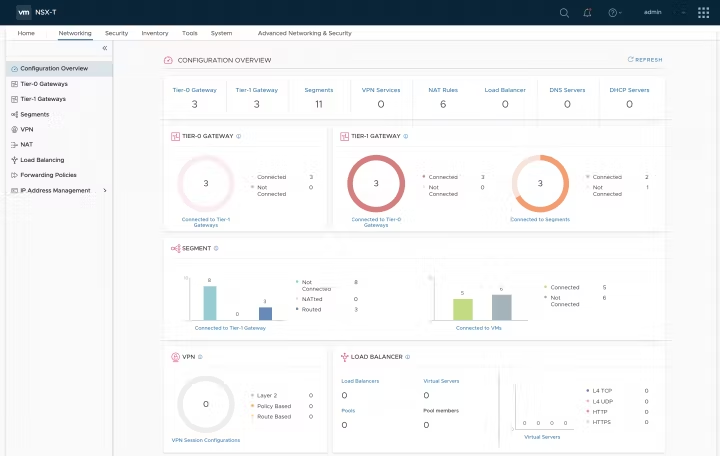
VMware NSX is a powerful network automation and virtualization platform designed for cloud-first enterprises. It enables enterprises to create, manage, and secure software-defined networks (SDN) across private, public, and hybrid environments.
Key Features
- Software-Defined Networking: Builds virtual networks independent of physical infrastructure.
- Micro-Segmentation: Protects workloads by isolating network traffic and limiting lateral movement.
Pros
- Ideal for cloud and hybrid environments.
- Deep integration with the VMware ecosystem.
Cons
- Complex deployment process.
- Best for VMware-heavy networks
7. ManageEngine Network Configuration Manager
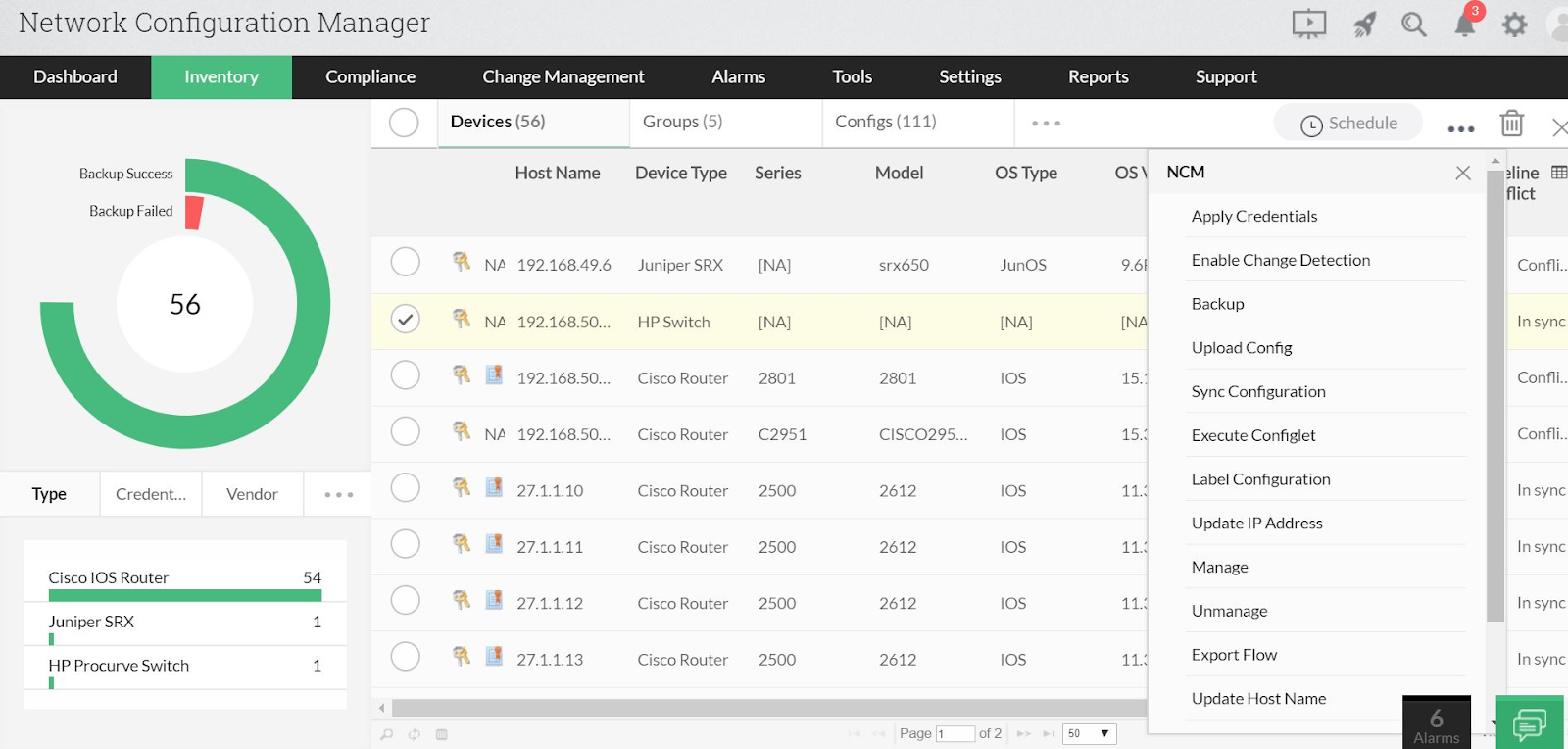
ManageEngine NCM is an affordable network configuration automation solution for small and medium enterprises. It automates backups, compliance audits, and configuration management for a wide range of network devices. The platform’s user-friendly interface makes it a go-to choice for IT teams with limited resources.
Key Features
- Automated Backups & Versioning: Keeps device configurations secure and easy to restore.
- Compliance Auditing: Tracks devices against internal and regulatory standards.
Pros
- Easy to deploy and use.
- Cost-effective for SMEs.
Cons
- Basic analytics capabilities.
- Fewer integrations compared to large platforms.
8. NetBrain

NetBrain is a dynamic network automation platform focused on visibility, mapping, and operational automation. It automatically generates interactive network maps and uses intent-based workflows to simplify troubleshooting and change management.
Key Features
- Dynamic Mapping: Auto-discovers and visualizes your entire network topology.
- Intent-Based Automation: Executes automated workflows to maintain desired network states.
Pros
- Excellent visualization tools.
- Strong ITSM and monitoring integration.
Cons
- Steeper learning curve.
- Can be resource-intensive.
9. Itential

Itential is a low-code network automation platform that helps IT teams design, orchestrate, and deploy automation workflows without heavy coding. It connects seamlessly with network, cloud, and security tools to simplify complex processes. With built-in compliance and API integration, Itential empowers teams to accelerate automation safely and efficiently.
Key Features:
- Low-Code Automation: Build workflows visually without scripting.
- Multi-Vendor Integration: Connects with major vendors and tools via APIs.
Pros
- Supports hybrid and multi-cloud environments.
- Robust API and integration support.
Cons
- May need customization for advanced cases.
- Complex interface for beginners.
10. Gluware
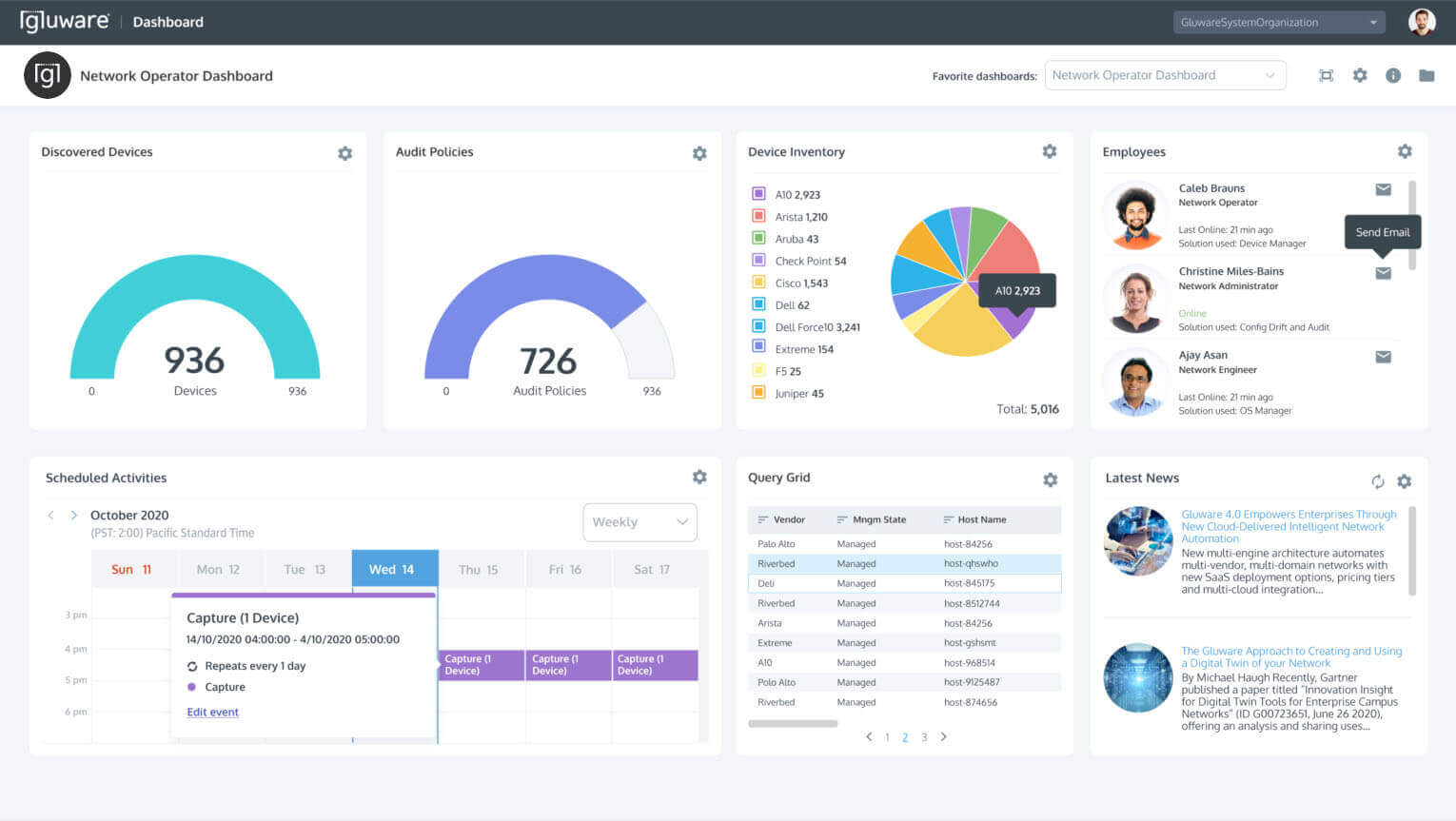
Gluware is an enterprise-grade network orchestration and automation platform built for large, complex, multi-vendor environments. It automates provisioning, policy management, and configuration tasks to eliminate manual errors and speed up deployment.
Key Features
- Intelligent Orchestration: Automates and coordinates network configurations at scale.
- Prebuilt Automation Packages: Speeds up setup with ready-to-use templates.
Pros
- Great for enterprise-scale networks.
- Reduces configuration errors and downtime.
Cons
- Requires training for advanced use.
- It may be overkill for small businesses.
How to Choose the Right Network Automation Tool?
With so many network automation tools available today, choosing the right one for your enterprise can feel overwhelming. Every tool promises speed, visibility, and control, but the real question is, which one fits your network, your team, and your long-term goals?
Here’s how to evaluate and select the best network automation solution for your enterprise:
1. Assess Existing Network Complexity
Start by understanding your current environment.
- How large is your network?
- How many devices, vendors, and configurations do you manage daily?
For smaller networks, simple network configuration automation tools may be enough to handle repetitive setup and update tasks.
But for large, hybrid, or multi-cloud infrastructures, you’ll need advanced tools with multi-vendor network automation support and orchestration capabilities.
Look for solutions that can scale with your enterprise, automating not just individual devices but entire workflows across data centers and clouds.
Here’s a pro tip: Choose a tool that grows with your business, not one you’ll outgrow in a year.
2. Evaluate Integration Requirements
The best network automation tools don’t work in isolation; they integrate seamlessly with your existing IT systems. Ensure the platform connects easily with your current monitoring, security, and configuration tools, such as SIEMs, firewalls, IAM systems, and ticketing platforms.
API compatibility is essential; it ensures smooth communication between your network automation solution and other technologies in your ecosystem. Also, check how well it supports multi-vendor environments; you don’t want a solution that only works with one brand of hardware.
Here’s a pro tip: Look for open APIs, SDKs, and plug-ins to simplify integration and reduce manual work.
3. Ensure Compliance and Security Alignment
Network automation isn’t just about convenience—it’s about control and compliance. Before choosing a tool, confirm that it supports your enterprise’s security frameworks and compliance standards, such as ISO 27001, NIST, SOC 2, or PCI DSS.
The tool should offer policy enforcement, audit trails, and automated compliance checks to ensure every network change is tracked, approved, and documented. Automated rollback features are also a plus—they help restore configurations quickly if something goes wrong.
Here’s a pro tip: Choose a platform that automates compliance without slowing down your operations.
4. Check Scalability and Performance
As your network expands, your automation tool should keep up. Assess whether the platform can manage thousands of devices, support multi-site deployments, and handle heavy traffic without lag. Tools with cloud-native architectures or distributed controllers perform better in large-scale, dynamic environments.
Here’s a pro tip: Look for platforms that offer horizontal scalability and real-time orchestration.
5. Consider Ease of Use and Learning Curve
Even the most powerful tool won’t help if your team struggles to use it. Look for solutions with an intuitive interface, clear workflows, and strong documentation. Platforms offering no-code or low-code automation options allow teams to build and deploy automation scripts faster; without deep programming knowledge.
Here’s a pro tip: A user-friendly tool reduces onboarding time and speeds up automation adoption across teams.
6. Evaluate Vendor Support and Community
A reliable support system can make or break your automation journey. Choose vendors that offer strong customer support, regular updates, and a knowledge base. For open-source network automation tools, check the strength of their community and how often they release patches or new integrations.
Here’s a pro tip: Active communities and responsive vendors ensure your tool stays secure and up to date.
Let’s check out this insightful episode of CloudEagle.ai’s SaaS Masterminds podcast, where Karl Haviland shares practical perspectives on AI, governance, and how to scale innovation responsibly.
Conclusion
Network automation is no longer optional; it’s essential for modern IT teams managing fast-growing, complex infrastructures. As networks expand across hybrid and multi-cloud environments, manual management just can’t keep up.
The right network automation tools can transform how your enterprises operate, automating configuration changes, improving visibility, ensuring compliance, and reducing costly downtime. These solutions give IT leaders the power to move from reactive problem-solving to proactive network optimization.
By investing in a smart network automation solution, your team can improve efficiency, strengthen security, and create a network that’s built to scale and adapt to future challenges.
Are you ready to simplify and secure your network?
Schedule a demo with CloudEagle.ai to see how automation can help your team reduce risk, control costs, and stay ahead of evolving network demands.
FAQs
1. What are the different types of network automation tools?
There are several types, including configuration management tools, monitoring tools, orchestration platforms, compliance automation tools, and AI-driven network solutions. Each type helps automate different parts of network management.
2. Which tool is best for automation?
The best tool depends on your network size and goals. Popular options include Cisco DNA Center, Ansible, SolarWinds, and Juniper Apstra. For flexibility, many IT teams also use open-source network automation tools like Ansible or NetBox.
3. What is CCNA automation?
CCNA automation refers to the automation topics covered in Cisco’s CCNA certification. It teaches how to use Python, APIs, and Cisco tools to automate basic network tasks and improve efficiency.
4. What is the role of API in network automation?
APIs (Application Programming Interfaces) allow automation tools to communicate with network devices and software. They enable automated configuration, monitoring, and data exchange between systems—making network automation faster and more reliable.
5. How do networking tools help with automation?
Networking tools help by automating repetitive tasks like device setup, configuration updates, and troubleshooting. This saves time, reduces human errors, and keeps networks running smoothly.

%201.svg)








.avif)




.avif)
.avif)




.png)









